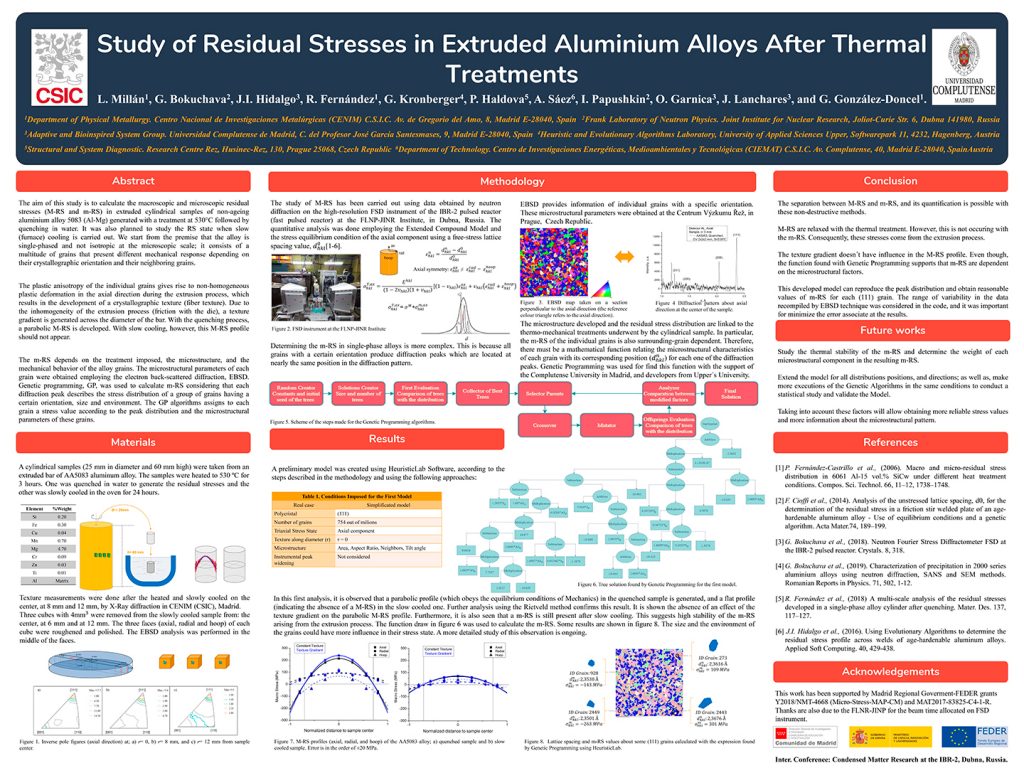Del 12 al 16 de Octubre de 2020 se ha celebrado la International Conference «Condensed Matter Research at the IBR-2» en el que Micro-Stress ha presentado el trabajo «Study of Residual Stresses in Extruded Aluminium Alloys After Thermal Treatments». El póster ha sido seleccionado para publicar una versión extendida en la revista Journal of Surface Investigation.
Resumen: El objetivo de este estudio es calcular las tensiones residuales macroscópicas y microscópicas (M-RS y m-RS) en muestras cilíndricas extruidas de aleación de aluminio no envejecida 5083 (Al-Mg) generadas con un tratamiento a 530 ° C seguido de temple en agua. También se planificó estudiar el estado de RS cuando se realiza un enfriamiento lento (horno). Partimos de la premisa de que la aleación es monofásica y no isotrópica a escala microscópica; consiste en una multitud de granos que presentan diferente respuesta mecánica en función de su orientación cristalográfica y de sus granos vecinos. La anisotropía plástica de los granos individuales da lugar a una deformación plástica no homogénea en ladirección axial durante el proceso de extrusión, lo que resulta en la desarrollo de una textura cristalográfica (textura de fibra). Debido a la falta de homogeneidad
del proceso de extrusión, se genera un gradiente de textura a lo largo del diámetro de la barra.
Las m-RS dependen del tratamiento impuesto, la microestructura y el comportamiento mecánico de los granos de la aleación. Los parámetros microestructurales de cada grano se obtuvieron empleando la difracción de electrones retro-dispersados, EBSD. La programación genética, GP, se utilizó para calcular las m-RS considerando que cada pico de difracción describe una distribución de estrés de un grupo de granos que tienen una cierta orientación, tamaño y ambiente. Los algoritmos GP asignan a cada grano un valor de tensión de acuerdo con la distribución de picos y los parámetros microestructurales de estos granos.
Abstract: The aim of this study is to calculate the macroscopic and microscopic residual stresses (M-RS and m-RS) in extruded cylindrical samples of non-ageing aluminium alloy 5083 (Al-Mg) generated with a treatment at 530°C followed by quenching in water. It was also planned to study the RS state when slow (furnace) cooling is carried out. We start from the premise that the alloy is single-phased and not isotropic at the microscopic scale; it consists of a multitude of grains that present different mechanical response depending on their crystallographic orientation and their neighboring grains.The plastic anisotropy of the individual grains gives rise to non-homogeneous plastic deformation in the axial direction during the extrusion process, which results in the development of a crystallographic texture (fiber texture). Due to the inhomogeneity of the extrusion
process (friction with the die), a texture gradient is generated across the diameter of the bar. The m-RS depends on the treatment imposed, the microstructure, and the mechanical behavior of the alloy grains. The microstructural parameters of each grain were obtained employing the electron back-scattered diffraction, EBSD. Genetic programming, GP, was used to calculate m-RS considering that each diffraction peak describes the stress distribution of a group of grains having a certain orientation, size and environment. The GP algorithms assigns to each grain a stress value according to the peak distribution and the microstructural parameters of these grains.
